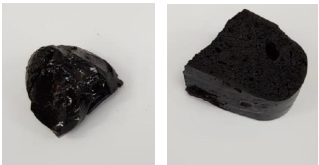Inorganic Analysis and Antioxidant Activity of Shilajit`
Keywords:
shilajit composition, minerals, trace metals, phosphate content, antioxidant activityAbstract
Shilajit is an ancient Hindu medication of Ayurveda which has many applications worldwide. This study aims to investigate the inorganic content of two common samples from Pakistan and Afghanistan used in the treatment of many diseases in Kingdom of Bahrain. The inorganic phosphate content of Afghani and Pakistani shilajit samples was determined to be 0.133 ?0.004 mg/g and 0.174 ?0.002 mg/g, respectively. Elemental analysis of solid Afghani and Pakistani shilajit samples was determined by energy dispersive x-ray fluorescence (ED-XRF). Afghani shilajit sample mainly comprised of calcium (50.298%), sulfur (21.299%), potassium (17.194%) and chlorine (8.405%) while the Pakistani shilajit mainly comprised of potassium (24.309%), calcium (20.933%), chlorine (18.614%), and silicon (15.197%) with relatively close percentages. Determination of the concentration of minerals and trace metals; As, Pb, Cd, Ag, Al, B, Ba, Cr, Cu, Fe, Mn, Ni, Sb, Se, Zn, P, Ca, K, Mg and Na, in each sample was carried out by inductively coupled plasma-optical emission spectrometry (ICP-OES). According to the ICP-OES analysis, the most significant outcome was the concentration of Ca and K in Afghani shilajit, which were determined to be 30292 and 21587 ppm (equivalent to 30.292 and 21.587 g/L), respectively. The antioxidant activity of both shiljait samples were evaluated by determining 2,2-diphenyl-1-picrylhydrazyl (DPPH) radical scavenging activity. The antioxidant activity of Afghani and Pakistani shilajit samples were determined to be 96.797 ? 0.561% and 95.297 ? 2.884%, respectively which may indicate strong antioxidant actions.
References
C. Carrasco-Gallardo, L. Guzm?n, and R. B. Maccioni, ?Shilajit : A Natural Phytocomplex with Potential Procognitive Activity?, International Journal of Alzheimer?s Disease, Vol. 2012, pp. 1?4, 2012.
V. Cagno, M. Donalisio, A. Civra, C. Cagliero, P. Rubiolo, and D. Lembo, ?In vitro evaluation of the antiviral properties of Shilajit and investigation of its mechanisms of action?, Journal of Ethnopharmacology, Vol. 166, pp. 129?134, 2015.
E. Wilson et al., ?Review on shilajit used in traditional Indian medicine?, Journal of Ethnopharmacology, Vol. 136, No. 1, pp. 1?9, 2011.
B. S. Kwon, A. I. Khlebnikov, I. A. Schepetkin, and S. B. Woo, ?Fulvic acid fractions from mumie?, in Proceedings, Vol. 3, pp. 352?355, 2004.
M. S. Musthafa et al., ?Ameliorative efficacy of bioencapsulated Chironomous larvae with Shilajit on Zebrafish ( Danio rerio ) exposed to Ionizing radiation?, Applied Radiation and Isotopes, Vol. 128, pp. 108?113, 2017.
M. S. Musthafa et al., ?Effect of Shilajit enriched diet on immunity, antioxidants, and disease resistance in Macrobrachium rosenbergii (de Man) against Aeromonas hydrophila?, Fish & Shellfish Immunology, Vol. 57, pp. 293?300, 2016.
A. Ali Redha, A. M. Hasan, and Q. Mandeel, ?Phytochemical Determinations of Pomegranate (Punica granatum) Rind and Aril Extracts and their Antioxidant, Antidiabetic and Antibacterial Activity?, Nat Prod Chem Res, Vol. 06, No. 04, 2018.
R. Korać and K. Khambholja, ?Potential of herbs in skin protection from ultraviolet radiation?, Phcog Rev, Vol. 5, No. 10, p. 164, 2011.
I. Rehan, R. Muhammad, R. Kamran, K. Karim, and S. Sultana, ?Quantitative Analysis of Shilajit using Laser-Induced Breakdown Spectroscopy and Inductively Coupled Plasma/Optical Emission Spectroscopy?, J Nutr Food Sci, Vol. 7, No. 4, 2017.
S. Das and D. Choudhuri, ?Dietary calcium regulates the insulin sensitivity by altering the adipokine secretion in high fat diet induced obese rats?, Life Sciences, Vol. 250, p. 1-12, 2020.
A. Rege, P. Juvekar, and A. Juvekar, ?IN VITRO ANTIOXIDANT AND ANTI-ARTHRITIC ACTIVITIES OF SHILAJIT?, International Journal of Pharmacy and Pharmaceutical Sciences,Vol. 4, No. 2, pp. 650?653, 2012.

Downloads
Published
How to Cite
Issue
Section
License

This work is licensed under a Creative Commons Attribution 4.0 International License.
Authors contributing to this journal agree to publish their articles under the Creative Commons Attribution 4.0 International License, allowing third parties to share their work (copy, distribute, transmit) and to adapt it, under the condition that the authors are given credit and that in the event of reuse or distribution, the terms of this license are made clear.





